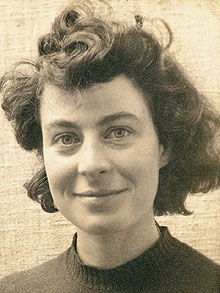Margaret Mellis facts for kids
Quick facts for kids
Margaret Nairne Mellis
|
|
|---|---|
 |
|
| Born | 21 January 1914 Wukingfu (Wujingfu), Swatow, China
|
| Died | 17 March 2009 (aged 95) |
| Nationality | Scottish |
| Education | Edinburgh College of Art |
| Known for | Abstract art |
| Spouse(s) |
|
Margaret Nairne Mellis (born January 22, 1914 – died March 17, 2009) was a Scottish artist. She was one of the first and last surviving members of a group of modernist artists. This group gathered in St Ives, in Cornwall, during the 1940s. Margaret and her first husband, Adrian Stokes, helped make St Ives a popular place for artists. Later, she married Francis Davison, who was also an artist. She also became a mentor to the famous young artist Damien Hirst.
Contents
Her Life Story
Margaret Mellis was born in Wukingfu (Wujingfu), Swatow, China. Her father was a Presbyterian missionary there. When she was one year old, her family moved back to East Lothian in Scotland. This happened shortly after the First World War began, so her father could join the army.
Early Education and Marriage
Margaret first wanted to study music. But she changed her mind and studied art at Edinburgh College of Art from 1930 to 1934. Her teachers included famous artists like Samuel Peploe, William Gillies, and John Maxwell. She also studied alongside other artists like Wilhelmina Barns-Graham and William Gear. She won a scholarship to travel and study art in Paris with André Lhote.
In 1936, she met Adrian Stokes, who wrote about art. They got married in 1938. After their honeymoon, they returned to London. There, Margaret continued her art studies at the Euston Road School.
Moving to St Ives
Before the Second World War started, Margaret and Adrian looked for a safe place away from London. In 1939, they moved to a house called Little Parc Owles in Carbis Bay, near St Ives. Their move to Cornwall was very important for the new modernist art movement. This movement became famous around the world in the mid-20th century.
Soon, other artists joined them in St Ives. These included Margaret's 17-year-old sister Ann Stokes, and their friends Ben Nicholson and Barbara Hepworth with their triplets. Naum Gabo and his wife Miriam Gabo also came. Later, Margaret's college friend Wilhelmina Barns-Graham joined them too. Margaret was encouraged to paint small abstract works and create detailed collage art. She was inspired by the simple, natural style of the artist Alfred Wallis. Her son, Telfer, was born in October 1940.
Many other artists visited this group in St Ives. These included Victor Pasmore, Graham Sutherland, William Coldstream, Julian Trevelyan, and Peter Lanyon. Later, a second group of artists like Roger Hilton, Patrick Heron, Terry Frost, and Bryan Wynter also came.
Life After St Ives
Margaret left the St Ives area in 1946 after her first marriage ended. She and Adrian Stokes divorced in 1946. Adrian later married Margaret's younger sister, Ann Stokes.
Patrick Heron introduced Margaret to another painter named Francis Davison. He had also recently divorced. They married in 1948 and lived for two years in a old castle in France. In 1950, they moved to Walberswick in England. Later, they moved to a small farm at Syleham, near Diss. They lived there for 25 years, mostly by themselves, with only occasional visits from artist friends. In 1976, they moved to Southwold. There, Margaret started making sculptures from driftwood.
Francis Davison passed away in 1984. Margaret Mellis lived on and was survived by her son, three grandchildren, and four great-grandchildren.
Her Art and Style
Margaret Mellis was known throughout her career for her use of colour. While she was in St Ives, influenced by Ben Nicholson, she started making relief art and collages. A famous example is Collage with Red Triangle II (1940). This piece was first a gift for Naum Gabo and is now in the Victoria and Albert Museum.
Changes in Her Art
After her first marriage ended, she stopped making abstract art for a while. She returned to painting things that looked more real. However, by the mid-1950s, her work started to move away from direct copies of things. She simplified still life paintings and landscapes into flat areas of pure colour. By the 1970s, her art was almost completely abstract. It focused on geometric shapes and colours.
Driftwood Sculptures and Later Influence
In 1980, Margaret Mellis began making sculptures from found pieces of driftwood. This became her main artistic focus until the end of her life. These works still had some elements that looked like real objects. But they were more about how shapes and colours related to each other. In the 1990s, Margaret became an early mentor and friend to the famous YBA artist Damien Hirst.
She did not have many art shows during her life. Damien Hirst believes that her work has not received enough attention. A big exhibition of her art was held at Newlyn Art Gallery in 2001. In 2008, a documentary called Margaret Mellis a Life in Colour was made. This film went along with a large exhibition of her work at the Sainsbury Centre for Visual Arts in Norwich. In 2011, her work was a major part of the Tate St Ives Summer Exhibition, shown alongside artists like Martin Creed and Agnes Martin. Her art can be seen in important collections. These include the Tate Gallery, the Victoria and Albert Museum, the Arts Council Collection, The Fleming Collection, City Art Centre, Edinburgh, and the National Galleries of Scotland.
In 2023, her work was part of an exhibition called Action, Gesture, Paint: Women Artists and Global Abstraction 1940 -1970 at the Whitechapel Gallery in London.

